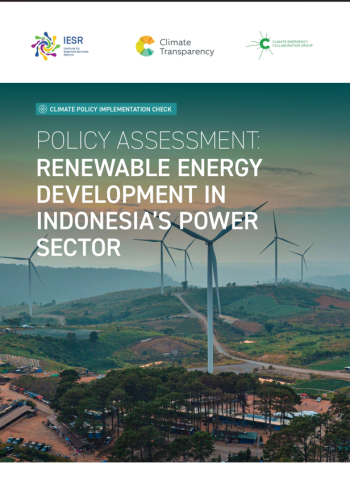The energy sector is the second largest greenhouse gases (GHGs) emissions contributor, accounting for 35% of total emissions, as stated in Indonesia’s Third Biennial Update Report (BUR). The power sector accounts for 43% of the total energy sector’s CO2 emission. Indonesia’s electricity generation mainly relies on fossil fuels, accounting for 81% of the total, with coal alone constituting 62% in 2021. Despite the inclusion of decarbonisation in the LTS-LCCR 2050, the ambition remains lacking, and the implementation planning must be improved.
The Government of Indonesia (GoI) aims to use the power sector, particularly through the National Electricity Plan (Rencana Umum Ketenagalistrikan Nasional/RUKN), to drive its emission reduction to meet its NDC targets. In the electricity sector, the NDC targets an additional 20 GW of installed RE, which will contribute 358 Mt CO2-eq unconditionally and 446 Mt CO2-eq conditionally by 2030. Given the importance of reducing carbon emissions in this sector, RUKN is critical in Indonesia’s decarbonisation efforts. The Indonesian government has also announced that the RUKN will be aligned with its Nationally Determined Contributions (NDCs) at different intervals due to their different issuance years.
Indonesia’s current new and renewable energy (NRE) target is 23% by 2025, with 10.6 GW of additional renewable power generation will be added by 2025 according to the National Electricity Supply Business Plan (Rencana Usaha Penyediaan Tenaga Listrik/RUPTL) 2021-2030. However, by 2022, the installed capacity of renewables was only at 12.3%. This situation is in line with the limited investments made. Indonesia targeted that investment in renewable will reach around USD 4 billion in 2022, yet the realised investment only accounts for USD 1.6 billion. This number is much smaller compared to the Ministry of Energy and Mineral Resource (MEMR) projection that USD 28.5 billion of investment is needed annually to reach net zero emission by 2060. In addition, the Ministry has also identified a number of obstacles to renewable energy investment, including but not limited to complicated bureaucracies, limited technical capacities, lack of planning, and limited access to financing for Independent Power Producers (IPP).
The Just Energy Transition Partnership (JETP), which deals with a total financial commitment of USD 21.5 billion, is expected to reduce the gap in renewable energy financing in Indonesia. As of November 2022, the JETP investment plan also set the target of 44% (previously 34%) renewable energy shares by 2030 and net zero in power sector by 2050. Indonesia needs to align the JETP target with future electricity plans. Although the JETP target is more ambitious than the RUKN, it is still not compatible with the Paris Agreement pathway. This shows that the synchronisation of Indonesia’s renewable energy targets is not yet available to guide a more ambitious decarbonisation path for the country.
To provide a more comprehensive review of the implementation of key policies and regulations related to RE development in Indonesia, this report assesses the current National Electricity Plan (RUKN 2019-2038). The assessment will also review its derivative, such as the RUPTL 2021-2030 with PT PLN (Persero) as the main implementing agency, and other applicable instruments in the power sector.
Keywords: Indonesia, decarbonization, renewable energy, power sector, NDCs, RUKN, RUPTL, JETP, investment, financing, emissions reduction

